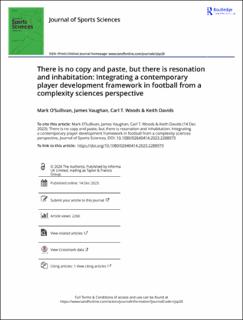| dc.contributor.author | O'Sullivan, Mark Joseph | |
| dc.contributor.author | Vaughan, James | |
| dc.contributor.author | Woods, Carl T. | |
| dc.contributor.author | Davids, Keith | |
| dc.date.accessioned | 2024-03-18T08:23:18Z | |
| dc.date.available | 2024-03-18T08:23:18Z | |
| dc.date.created | 2024-01-03T13:00:16Z | |
| dc.date.issued | 2023 | |
| dc.identifier.citation | Journal of Sports Sciences. 2023, Artikkel 2288979. | en_US |
| dc.identifier.issn | 0264-0414 | |
| dc.identifier.uri | https://hdl.handle.net/11250/3122779 | |
| dc.description | This is an Open Access article distributed under the terms of the Creative Commons Attribution License (http://creativecommons.org/licenses/by/4.0/), which permits unrestricted use, distribution, and reproduction in any medium, provided the original work is properly cited. The terms on which this article has been published allow the posting of the Accepted Manuscript in a repository by the author(s) or with their consent. | en_US |
| dc.description.abstract | Socio-cultural constraints shape behaviour in complexifying ways. In sport, for example, interconnected constraints play an important role in shaping the way a game is played, coached, and spectated. Here, we contend that player development frameworks in sport cannot be operationalised without careful consideration of the complex ecosystem in which they reside. Concurrently, we highlight issues associated with frameworks designed in isolation from the contexts in which they are introduced for integration, guised as trying to “copy and paste” templates from country to country. As such, there is a need to understand the oft-shrouded socio-cultural dynamics that continuously influence practice in order to maximize the utility of player development frameworks in sport. Ecological dynamics offers a complexity-oriented theoretical lens that supports the evolution of context-dependent player development frameworks. Further, tenets of the Learning in Development Research Framework can show how affordances are not just material invitations but constitute a vital component of a broader socio-cultural form of life. These ideas have the potential to: (1) push against a desire to “copy and paste” what is perceived to be “successful” elsewhere, and (2), guide the integration of player development frameworks by learning to resonate with the nuanced complexities of the broader environment inhabited. | en_US |
| dc.language.iso | eng | en_US |
| dc.subject | athlete development | en_US |
| dc.subject | complex systems | en_US |
| dc.subject | contextual complexity | en_US |
| dc.subject | ecological dynamics | en_US |
| dc.subject | sport coaching | en_US |
| dc.title | There is no copy and paste, but there is resonation and inhabitation: Integrating a contemporary player development framework in football from a complexity sciences perspective | en_US |
| dc.type | Peer reviewed | en_US |
| dc.type | Journal article | en_US |
| dc.description.version | publishedVersion | en_US |
| dc.rights.holder | © 2024 The Author(s) | en_US |
| dc.source.pagenumber | 10 | en_US |
| dc.source.journal | Journal of Sports Sciences | en_US |
| dc.identifier.doi | 10.1080/02640414.2023.2288979 | |
| dc.identifier.cristin | 2219879 | |
| dc.description.localcode | Institutt for idrett og samfunnsvitenskap / Department of Sport and Social Sciences | en_US |
| dc.source.articlenumber | 2288979 | en_US |
| cristin.ispublished | true | |
| cristin.fulltext | original | |
| cristin.qualitycode | 2 | |
